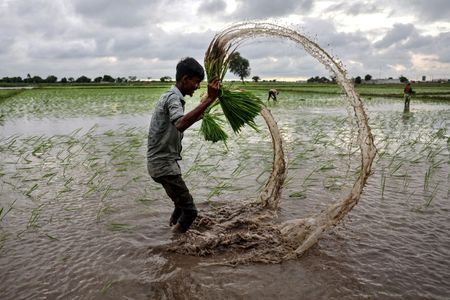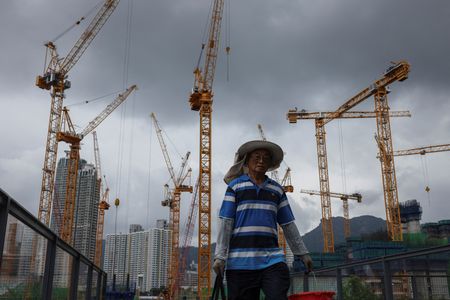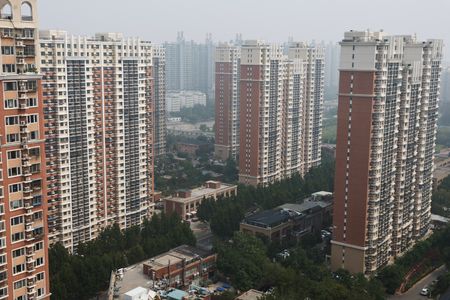By Rajendra Jadhav
MUMBAI (Reuters) -Global rice prices, which have tumbled to multi-year lows, are unlikely to fall further with top exporter India’s currency firming, but bulging Indian stockpiles and a bumper Asian crop will cap any rebound this year, industry executives say.
While lower rice prices will benefit price-sensitive consumers in Africa and other regions, they are likely to further squeeze the already meagre earnings of farmers across Asia, which produces nearly 90% of the world’s rice.
The market slumped in April, a month after Delhi removed the last of its export curbs on the grain imposed in 2022, sending Indian parboiled rice export prices to a 22-month low. Prices in Thailand dropped to their lowest in more than three years, while in Vietnam, they sank to near five-year lows.
Following a slide of nearly one-third from their 2024 peaks, prices have found a floor, traders and industry executives said, but will hold there for the rest of 2025 limited by surpluses in all major exporting countries.
“Even after the recent significant correction, we don’t expect a price rebound. The supply glut will likely prevent prices from increasing,” said B.V. Krishna Rao, president of the Rice Exporters Association.
The association expects prices will fluctuate within a $10 range around $390 per ton for 5% broken rice for the rest of the year.
“Prices will remain around the current level unless the monsoon pulls a surprise and affects production,” said Himanshu Agrawal, executive director at Satyam Balajee, a leading rice exporter.
BUMPER OUTLOOK FOR INDIAN EXPORTS
A good spell of monsoon rains is vital for the rice crop, which requires copious amounts of water. India’s state-run weather office has forecast above-average monsoon rains for a second consecutive year in 2025, which will boost production.
Global rice output is expected to reach a record 543.6 million metric tons in 2024/25, up from 535.4 million tons the previous year, according to estimates from the Food and Agriculture Organization.
Total global supply, including stocks, is seen at 743 million tons, well above demand that is expected to rise to 539.4 million tons, the FAO estimates.
In India alone, rice stocks, including unmilled rice paddy, in government warehouses totalled 63.09 million tons on April 1, nearly five times a government target of 13.6 million tons.
With massive stocks and the expected rebound in production, buyers are in no rush to make purchases, while sellers are competing for market share – keeping global prices under pressure, said Agrawal.
The Rice Exporters Association expects shipments from India to rise by nearly 25% from a year earlier to a record 22.5 million metric tons this year.
Olam Agri India, one of the world’s top rice exporters, is even more bullish, projecting exports could climb to as much as 24 million tons.
The jump is likely to propel India back to its dominant share of the global market, which stood at more than 40% before it curbed exports in 2022, surpassing the combined sales of the next four largest suppliers – Thailand, Vietnam, Pakistan, and the United States.
“India has already started to reclaim its lost market share,” said Nitin Gupta, senior vice president at Olam Agri India.
RUPEE REBOUND, STATE DEMAND CREATE A FLOOR
When India’s broken rice came back to the market in March, demand was stoked by a weak rupee, trading around 87.2 against the dollar, which helped to drive prices down.
However, the rupee has since recovered to 84.55 against the dollar, and other exporting nations’ currencies have strengthened, too, which has prevented global rice prices from falling further, three grain dealers said.
Further providing a floor, Indian farmers have the option to sell paddy to the government. If exporters begin offering lower prices than the state-fixed price, farmers will start selling to the government.
The government raises its minimum support price annually, another factor that will keep export prices from dropping further.
RATTLED RIVALS
Forecasts of higher supplies from India have rattled rival suppliers.
In the first quarter of 2025, Thailand’s rice exports fell 30% to 2.1 million tons, as India offered the staple at lower prices prompting buyers to switch, said Chookiat Ophaswongse, honorary president of the Thai Rice Exporters Association.
For 2025, Thailand’s exports are likely to drop 24% from a year ago to 7.5 million tons, while Vietnam’s are expected to fall 17%, also to 7.5 million tons, trade bodies in the two countries estimate.
A 30% year-on-year slide in rice paddy prices in Thailand in February sparked protests by farmers and prompted the government to offer a subsidy to rice growers. In an effort to support its farmers, Thailand has sought cooperation from India and Vietnam to address falling rice prices, the Thai commerce minister said in March.
Benefiting from the price slump are the top rice-importing countries – the Philippines, Indonesia, Saudi Arabia, and African countries such as Senegal, Nigeria, and Ghana.
In Ivory Coast, rice demand has grown with an influx of people from neighbouring countries, said Yacouba Dembele, director of the Agency for the Development of the Rice Sector.
“India’s export curbs were a bonanza for other Asian suppliers in the past two years. Now, the resumption in exports would make buyers happy with the moderation in prices,” said Rao at the Rice Exporters Association.
(Reporting by Rajendra Jadhav; Additional reporting by Panarat Thepgumpanat in Bangkok and Loucoumane Coulibaly in Abidjan; Editing by Mayank Bhardwaj and Sonali Paul)











